Microsoft Windows
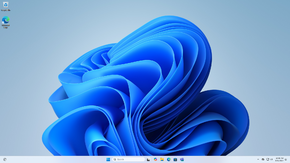 | |
| Developer | Microsoft Corporation |
|---|---|
| Source model | Closed source |
| Initial release | Windows 1.0 (20 November 1985) |
| Latest release | Windows 11 2024 Update (1 October 2024) |
| Latest preview | Selenium (build 27813) (12 March 2025) |
| Supported platforms | x86, AMD64, ARM32, ARM64; see § Supported platforms for details |
| Kernel type | Hybrid (NT) |
| User interface | Windows desktop |
| License | Proprietary |
Microsoft Windows, commonly referred to as Windows, is a family of proprietary graphical operating systems developed by Microsoft, which includes various products for different markets and industries that use a similar user interface and feature set. The original version of Windows was a graphical environment running on top of MS-DOS, although later versions increasingly took on the characteristics of a full operating system. Since Windows XP, all desktop versions of Windows use the portable NT hybrid kernel that does not rely on MS-DOS.
The Windows family currently encompasses the main consumer version named simply Windows, as well as Windows Server for the server market and Windows IoT for the embedded market, although they are all based on the common desktop Windows codebase. In the past, the family also included Windows RT for ARM-based tablets, Windows Phone or Windows Mobile for smartphones, Windows Embedded Compact, or the MS-DOS based line. An internal modularization effort, Windows Core OS (also based on the NT kernel, but not based on desktop Windows), was previously in development but was eventually abandoned due to bureaucratic and technical shortcomings.
Since Windows 95, most Windows versions have used the same user interface that included the Start menu, a taskbar on the edge of the screen and a desktop, as well as overlapping or full screen windows with controls in their top right.
History
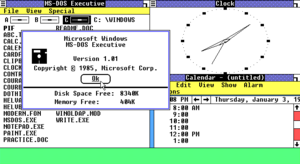
Microsoft Windows was first announced at the Fall COMDEX 1983 computer expo as a cooperative multitasking desktop environment with a tiling window manager. Contrary to popular belief, the tiling was not a design nor legal limitation, but rather a conscious choice for main application windows backed by research at Xerox PARC, where some members of the Windows team had previously worked at. Windows did indeed fully support overlapping windows, though in practice the ability was originally only used for popup windows and certain controls such as menus and dropdowns. Although Windows ended up supporting MS-DOS hosts only until the introduction of Windows NT, Microsoft also considered porting Windows to Xenix as well as the multitasking MS-DOS 4. However, ultimately neither port ended up materializing.
After multiple delays in its development, Windows 1.0 finally hit the market on 20 November 1985 and achieved modest success, with over 500 thousand copies sold during its shelf life. Several minor updates were released in the following years, adding support for more hardware and languages. The first version used the MS-DOS Executive, a simple file manager, as a shell, which is generally the first application ran on startup providing the user experience. Other applications in the package included Calculator, Cardfile, Clipboard Viewer, Clock, Control Panel, Notepad, Paint, Reversi, Spooler, Terminal, and Write.
A major update called Windows 2.0 was released in 1987 adding features such as universally overlapping windows, which later lead to Apple filing a lawsuit for copyright infringement. This version also introduced general support for VGA and PS/2 mouse. A separate edition called Windows/386 was also introduced that took advantage of the virtual 8086 mode of the i386 processor to preemptively multitask MS-DOS applications under Windows; this would be later known as the 386 Enhanced Mode and become the cornerstone of Windows 9x. In later revisions of the Windows 2.0 series, the original edition was renamed Windows/286.
The Windows project was sidetracked for a while after the release of Windows 2.0, as Microsoft moved its focus onto OS/2, the operating system developed jointly with IBM. The first version, OS/2 1.0, was released in 1987 but didn't include any graphical user interface and could only run text mode applications. The following version, OS/2 1.1 from 1988, introduced a native GUI layer called the Presentation Manager, the design of which was largely influenced by Windows, although there were key differences that made it practically impossible to write a program for one environment and then recompile it for the other without large changes. Notably, the Graphics Device Interface (GDI) component of Windows was replaced by a new graphics engine. As Windows compatibility was not a concern, Microsoft also took the opportunity to clean up some of its design mistakes.
With the release of OS/2 with the Presentation Manager, Microsoft originally expected that most users and developers would eventually migrate to the new operating system. However, as the company grew increasingly dissatisfied with many of IBM's corporate policies and the adoption of Windows slowly gained traction, Microsoft started to reevaluate its operating system strategy. When David Weise, a Windows developer, demonstrated his skunkworks port of Windows to the Intel 80286 processor's protected mode to Steve Ballmer and Bill Gates, the decision to produce a new major version of Windows was finally greenlighted.
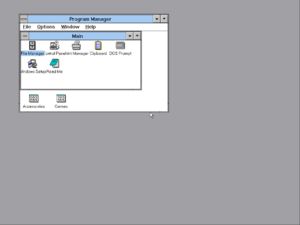
Windows 3.0 was released in 1990 and became the first widely successful version of Windows. The new features included a revamped user experience consisting of the Program Manager, which allowed easy management of installed applications. A new File Manager was also included to replace the former shell, which was now deprecated. The previously separate 286 and 386 editions of Windows were unified into one version with the ability to operate in three different modes according to the hardware configuration:
- Real mode, which was intended for computers with the original 8088/8086 processor. This was also the only mode which fully supported applications written for earlier versions of Windows.
- Standard mode, which used the protected mode of the 286 and 386 processors in order to gain access to memory beyond the first 640K, although it still switched to real mode to run MS-DOS applications.
- 386 Enhanced mode, which in addition to the protected mode also used the 386 processor's ability to create and manage virtual machines for real mode MS-DOS applications.
A major update dubbed Windows 3.1 followed in 1992, introducing the new flag logo with colored panes. The user interface was refreshed in this release, including new, more vivid icons. This version of Windows removed support for real mode and the MS-DOS Executive application. It was accompanied by Windows for Workgroups 3.1 with integrated networking support. An add-on pack named Win32s was also introduced in 1992, which allowed Windows 3.1 users to run simpler 32-bit Windows applications in the otherwise 16-bit environment and provided early testing for a more complete Win32 implementation in the next major version of DOS-based Windows.
The last minor update to the series, Windows for Workgroups 3.11 was released in 1993 and introduced 32-bit disk access as well as removed the Standard mode, raising the minimum required CPU to a 386. A 32-bit TCP/IP stack was ported from an early version of Windows 95 and released in 1994 as a downloadable plugin for Windows for Workgroups 3.11.
Windows NT
In 1988, Microsoft hired Dave Cutler, a former DEC engineer, to create a portable 32-bit version of OS/2 under name NT OS/2, the operating system that the company worked on in collaboration with IBM. At the time OS/2 was a 16-bit operating system very much tied to the x86 platform with considerable DOS heritage. The new operating system intended to be a preemptive multitasking system with multiprocessing support. The design included a portable kernel with executive services layered on top of a hardware abstraction layer, and multiple environmental subsystems running in user mode offering support for multiple APIs. Portable OS/2, or NT OS/2, would have included support for both 16-bit and extended 32-bit variant of the OS/2 API, as well as virtual DOS machines and an implementation of the POSIX standard, which would allow Microsoft to run for US government contracts. Commercial release was planned for the early 1990s with NT shipping as OS/2 3.0, while IBM was adding 32-bit support to the original OS/2 codebase to create OS/2 2.0.[1]
Initially, NT was developed for the Intel i860 processor, targeted to both personal computers and servers, partially to ensure portability by preventing programmers from introducing x86-specific paradigms into code. When the team learned about the disappointing performance of the i860, the operating system was ported to the i386 and MIPS architectures.
Following the success of Windows 3.0 in 1990, Microsoft revised its OS/2 plans as a part of its new "Windows Everywhere" strategy, which tried to position Windows as a common environment that could run the same apps on DOS and OS/2 as well as on the new NT platform. This included the addition of a Windows subsystem to OS/2 3.0 as a peer to the existing OS/2 environment.[2][3] However, this didn't improve the already deteriorating Microsoft-IBM relationship and eventually led to its collapse. The design of NT was then further changed and Windows became the main environment providing the system's user interface, while OS/2 support was reduced to character mode OS/2 1.x applications. The change was first announced in January 1991 with the new operating system initially being called Advanced Windows.[4][5]
A user interface was added to Windows NT in the first half of 1991, with network support following during summer. The first prototype version was shipped to selected partners in September and the new operating system was publicly demonstrated for the first time at Fall COMDEX 1991 in October. A MIPS build first shipped in a December release. Later builds added crucial components such as the registry, NTFS and the ability to run 16-bit MS-DOS and Windows applications. Windows NT 3.1 was finally released on 27 July 1993 in workstation and server flavors.
The next minor version, Windows NT 3.5 was released in 1994 and included performance improvement as well as a new full TCP/IP stack, long filename (LFN) support on the FAT file system and other refinements. Windows NT 3.51 was released in 1995, which ensured compatibility with the upcoming Windows 95 and added support for the PowerPC architecture, the PCMCIA interface, as well as file compression, or replaceable GINA.
Windows 9x
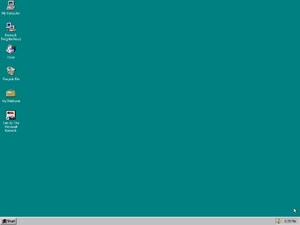
Microsoft first announced a 32-bit version of Windows that would run on top of MS-DOS in 1991. Several plans for a low-end Win32 environment were considered, including a variant of the NT kernel cut down in order to run on an average Windows 3.1 computer. In the end, Microsoft decided to build the new version on top of MS-DOS and Windows in 386 Enhanced mode.
On 24 August 1995, Microsoft released Windows 95, previously known under its codename "Chicago", with a brand-new user interface with a Start menu, taskbar, and the desktop, as provided by the new Windows Explorer. Although previous versions already included certain 32-bit components, it was the first version to be able to run most 32-bit user applications, while it kept a great degree of compatibility with already existing 16-bit ones. Among other improvements in this version was the support for long filenames through an extension to the FAT16 file system.
Windows 95 was the first widespread release of Windows to be integrated with a specific MS-DOS version, although Windows 3.1 was also available before in combined packages with MS-DOS 5 and later MS-DOS 6 (as the results of the Janus project). However, MS-DOS 7 in Windows 95 was used only as a bootloader and a compatibility layer for older device drivers. Most MS-DOS user applications were either extended with Windows code or entirely replaced with a Windows version, keeping only the ones that were required to run without Windows, e.g. during the OS installation, such as FDISK and FORMAT.
The new user interface was also ported to the Windows NT line, with several Shell Technology Previews being released for Windows NT 3.51 during the development of Chicago and the Shell Update Release shipping in 1996 as Windows NT 4.0. Alongside the new shell, Windows NT 4.0 also notably moved a part of the GUI stack into kernel mode, which greatly improved performance.
During its lifetime Windows 95 saw several larger updates dubbed the OEM Service Releases (OSR) that were released only to computer manufacturers, specifically OSR 1.0, OSR 2.0, OSR 2.1, and OSR 2.5. A Service Pack was also released that updated an RTM copy of Windows 95 to the OSR 1.0 level. In 1997 a USB Supplement was released for OSR 2.x that added support for the then-new Universal Serial Bus interface.
The classic Windows line received a major update on 25 June 1998 with the release of Windows 98, codenamed "Memphis". It was the first version to integrate Internet Explorer deeply into the operating system's user interface as a part of the Windows Desktop Update. Many parts of the UI started using HTML and Internet Explorer's rendering engine to present a web-like user interface. A feature called Active Desktop made it even possible to set a webpage as the desktop background. Under the hood Windows 98 introduced the new Windows Driver Model, which enabled the use of the same drivers on Windows 9x as well as on the radically different Windows NT based operating systems.
A year later, Windows 98 received an update which was called the Second Edition, which included a new version of Internet Explorer, added Internet Connection Sharing and improved USB support.
In 2000, Windows Me (Millennium Edition), the last release of the classic Windows line was released. It carried over the improvements made to the user interface in its NT-based counterpart, Windows 2000. Windows Me is based on Windows 98, however, access to the real mode MS-DOS was restricted in order to decrease boot time among other changes to the kernel. It was infamously known for its stability problems partially caused by OEMs recycling drivers designed for Windows 98 under its new driver model, as the revamped kernel wasn't designed with VxD-based drivers in mind. The project was also under time crunch towards release following the cancelation of the Neptune project. It was replaced by Windows XP in 2001, ending the era of DOS-based Windows.
Windows 2000 and Windows XP
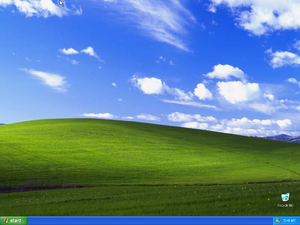
In the late 1990s, it became more feasible to discontinue the aging Windows 9x line and release a consumer version based on Windows NT. Microsoft started work on the next version of Windows NT immediately after the release of Windows NT 4.0, which would improve the user experience of the high-end operating system. Similar to Memphis, the user interface of Windows NT 5.0 initially used Internet Explorer 4.0 with the Windows Desktop Update, being later updated to 5.0 and then 5.5 during development. Management tools, most of which were left unchanged since the first NT release, were rewritten using the new Microsoft Management Console. On servers, the new version brought improvements from the canceled Cairo project, such as Active Directory.
Beside working on the successor of Windows NT 4.0, Microsoft also released several new editions based on the NT 4.0 codebase. An Enterprise edition of Windows NT 4.0 Server was released in 1997, which was the predecessor of the Advanced Server SKU of later versions and was intended for high traffic and high demand workloads. Terminal Server Edition followed in 1998, which introduced the Terminal Services feature, allowing remote access to Windows computers. Windows NT Embedded 4.0 was introduced in 1999, a specialized version of the Workstation edition that allowed embedded vendors to pick only the required OS components for the intended workloads.
As Windows NT 5.0 got further delayed, the consumer NT aspect was moved into a following release codenamed Neptune, which would succeed Windows 98 and later Windows Me. In 1998, Microsoft announced that Windows NT 5.0 would be called Windows 2000, dropping the NT moniker to mark the NT technology becoming mainstream. In the end, it was released on 17 February 2000 with Internet Explorer 5.5 and earned the reputation as one of the most stable versions of Windows.
Work on Neptune began several months before Windows 2000 was completed. The Neptune team heavily cooperated with the team working on Millennium, with the two projects sharing certain components. Development concentrated on a new task-oriented user interface called Activity Centers, which was also included in contemporary Millennium builds. The project also toyed around with the idea of hybrid startup, later implemented in Windows 8. Neptune was canceled in early 2000 together with its business counterpart codenamed Odyssey and replaced with a new, more conservative project codenamed Whistler that would eventually become Windows XP.
Windows XP was released on 25 October 2001 and was a relatively minor update to Windows 2000, mostly focusing on user experience and better compatibility with Windows 9x. A new theme called Luna was introduced, replacing the classic theme used in previous versions. A new login screen and fast user switching was also added, as well as better support for digital cameras, MS-DOS emulation and wireless networking. Windows XP was originally released in Home Edition and Professional variants, with an embedded version following a few months after. The 64-Bit Edition was also originally launched for the Itanium (IA-64) architecture.
Two additional editions for consumer use were introduced in 2002, both based on the original Professional edition. Windows XP Media Center Edition added the Windows Media Center (and later the Royale theme), while Windows XP Tablet PC Edition added tools and games for use on a Microsoft Tablet PC.
Development of the server counterpart continued after the release of the client version, resulting in Windows Server 2003, which was released in spring 2003 and used a newer kernel. It was also the base for an updated version of the Windows XP 64-Bit Edition. Work on an AMD64 version started late in the development process and finished in 2005 with the release of x64 editions of both Windows Server 2003 and Windows XP Professional (also based on 2003 codebase).
The Windows XP Starter Edition was introduced in 2004 for developing markets, including various Asian and South American countries and Russia. It is based on the original Home Edition but is noticeably more limited with some features removed and only 3 programs being allowed to run at a time.
In 2005, Microsoft was forced to introduce a version of Windows XP without the Windows Media Player to the European market[6] after the European Commission ruled that the company had been breaking its near monopoly in the operating systems market by including the player. The company therefore came up with a new edition originally called Windows XP Reduced Media Edition that included neither Windows Media Player nor Windows Movie Maker, although the user could download them for free from Microsoft's website. European authorities however objected to the name and instead suggested the N suffix for both Home Edition and Professional, standing for "not with Media Player".[7][8] The N editions were available for the same price as the regular variants, which led to low consumer demand and some OEMs not offering it for sale at all. The K and KN editions were introduced in 2006 after a similar ruling by South Korean authorities, with the K edition adding links to third party media player and instant messaging software, and the KN edition in addition removing the Windows Media Player and Windows Messenger.
Windows Vista and Windows 7
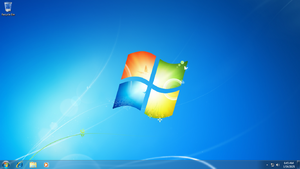
Work on a new, major release of Windows had already started before development of Whistler concluded. The project, codenamed Blackcomb as a reference to the Whistler Blackcomb ski resort in British Columbia, was originally announced as the successor of Windows XP with new features such as a .NET user interface, integration with web services, or an advanced storage subsystem. However, the company realized that it wouldn't be able to hit the expected release date of late 2002 with the planned feature set and decided to first ship a bridge-gap release known as Longhorn, named after a bar between the two mountains, followed by Blackcomb itself in 2003 or 2004.
Development of Longhorn started in 2002, initially as a spinoff of the still-ongoing server version of Windows XP. At the time, Longhorn work was mostly confined to Lab06, the lab that worked on the Windows shell and user experience. As Windows Server 2003 finished development, Longhorn development fully took off as new features such as Avalon or WinFS were added. With the cancellation of Longhorn Server in late 2002, most user experience features were moved to Longhorn while server-oriented improvements were slated for Blackcomb.
As development progressed, many features originally planned for Blackcomb became part of Longhorn, causing both projects to be postponed even further. The project was subject to severe feature creep, as well as organizational issues. Many components were extended using the .NET Framework and Managed Extensions for C++, both still relatively new technologies at the time, which lead to increasing stability issues. Most builds were plagued with memory leaks, resulting in only two semi-public releases during this period. Managed Extensions for C++ were later deprecated and replaced with C++/CLI as a direct result of the negative experience from its usage in Longhorn.
In the end, the Longhorn project was reset in the middle of 2004. The feature set was reviewed and many features such as WinFS or Castles were postponed or canceled in order to create a more realistic set of goals for the new major version. The remaining features were reimplemented in C/C++ as a ban on .NET code was introduced, with the exception of Windows Media Center. The first public build of Longhorn after the reset was released to WinHEC 2005 attendees in the spring of 2005, followed by the first beta release three months later, which introduced the Windows Vista name.
The development continued at a steady pace, with Beta 2 shipping in May 2006 and two release candidates following in the months after. Windows Vista was finally released on 30 January 2007 in considerably more editions than its predecessor, which included Starter, Home Basic, Home Premium, Business, Ultimate and Enterprise. The new version included a new overhauled user interface called Windows Aero, as well as new security features such as User Account Control. It grew on to become one of the most disliked releases of Windows due to its immense lack of stability of the original release, although later updates greatly improved the situation. The large jump in system requirements caused by the long gap since the last Windows release and computer manufacturers marking underperforming systems as Vista Capable also contributed to its bad reputation. The server counterpart, Windows Server 2008 was released a year later on 27 February 2008 and is based on Windows Vista Service Pack 1.
As Windows Vista was nearing completion in early 2006, the Blackcomb project was renamed to Vienna. However, so many features have been postponed into it after the development reset in 2004 that its objectives became very unrealistic, which lead to its eventual cancelation. A new project codenamed Windows 7 was set up in its place, which aimed to make minor improvements to the core Windows Vista experience such as introducing the Superbar, Libraries and Homegroups and addressing the negative feedback its predecessor faced. It was released on 22 October 2009 together with Windows Server 2008 R2 and became one of the most popular versions, with as much as 20% of all Windows users still using it as of 2021.
Windows 8
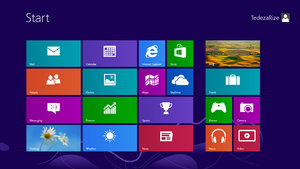
The popularity of devices utilizing touch input grew significantly during the late 2000s, and while Windows tried to cater to these audiences with the introduction of the Windows XP Tablet PC Edition and later the integration of its features into regular editions of following Windows versions, the Microsoft Tablet PC concept was ultimately rendered obsolete with the introduction of the original iPad in 2010. Unlike the Tablet PC, which usually was an x86-based laptop with a touch screen controlled by a stylus, the iPad was ARM-based, didn't include a hardware keyboard and was optimized for finger touch. This led Microsoft to work on a new version of Windows that would be better suited for such devices.
Work on an ARM port of Windows, internally called Windows on ARM or WOA, also started soon after Windows 7 was finished. The core system together with simple apps were able to run on an Asus P835 smartphone as soon as January 2010. The new port was announced at the 2011 Consumer Electronics Show in January 2011, with the full Windows desktop shown running on boards using nVidia and Texas Instruments system-on-chip circuits.
A new user interface based on the Metro design language was also introduced alongside the Windows Runtime, an application platform used for new, Modern apps designed for it. The new interface, also commonly called Metro, was designed from the ground up with touch input in mind—the new Modern apps ran in full screen and a second app could be snapped to a side with a large enough screen, allowing for up to two apps to be visible at any time. The Start menu was redesigned as a full screen interface with differently sized tiles, some of which could also display certain information using a feature known as Live Tiles. It also made great use of touch and mouse gestures, to the point that the Start button was replaced by such a gesture. An almost finished version of Metro was first demonstrated in June 2011 at the D9 All Things Digital conference.
Prior to the official announcement of Windows 8, the new features in its pre-release builds were infamously locked down using Redpill, which made it notoriously difficult to research these features even after release. The Developer Preview released during the Microsoft Build 2011 conference in September 2011 is one of the last known builds that still contain the mechanism, although it was already unlocked prior to its distribution. Two more public previews as well as multiple private previews followed in the upcoming months. Windows 8 was finally released on 26 October 2012 alongside Windows Server 2012, and aside from the new Metro interface and ARM port (released as Windows RT), it also included a redesigned File Explorer and Windows To Go, as well as general performance improvements.
Although Metro was generally well received as a tablet user experience, Windows 8 overall was criticized as being way too optimized for touch input to the point of considerably worsening the experience for the majority of Windows users who use a mouse and a keyboard. A large sore point of Windows 8 was the integration of Metro with the traditional desktop—or the lack thereof, as Metro did not attempt at all to integrate with the traditional desktop, which was instead treated as yet another app. Overall, the desktop was considered an obsolete platform by Microsoft, as barely any new desktop APIs have been introduced. This went as far as artificially limiting Windows RT to only run Modern applications and whitelisted desktop applications, which ultimately contributed to its market failure.
A minor update, Windows 8.1 was released on 17 October 2013 as a free upgrade for Windows 8 users and addressed some of the general nuisances by restoring the Start button on the taskbar, or adding the ability to boot to the desktop upon logging in. The Metro interface was also improved with updates to the Start screen, which now supported more tile sizes and was more customizable, improved snap view functionality which now allowed more than two apps to be snapped together and a new unified Search experience based on Bing. Later updates continued the trend of improving usability with the mouse by showing Modern apps in the taskbar, as well as introducing a more traditional title bar for Modern apps with a Close and Minimize button. The server counterpart, Windows Server 2012 R2 was released a day later on 18 October 2013.
Windows 10 and Windows 11
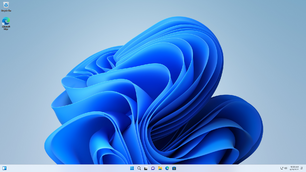
Development of Windows 10 started after the release of Windows 8.1 in late 2013. The goal was to create a single unified platform that would run on desktop and laptop computers, tablets, smartphones, all-in-one devices and the Xbox and to create a unified application development platform that would also allow apps to run on all Windows 10 based devices. It also aimed to make major improvements to various aspects of the user interface of the operating system that were criticized in Windows 8.x like bringing back the Start menu, putting the desktop back at center focus and more.
Microsoft also made major changes to how Windows was built and tested by introducing the Windows Insider Program which boosted the company's engagement with beta testers as well as distributing new pre-release builds more frequently than the prior beta testing initiatives. This also greatly cut down the number of leaks from within the company, which in the past bothered the company due to legal complications of licensed features becoming available earlier than expected.
Windows 10 also introduced a new release model called Windows as a service. This allowed new features and improvements to be added more frequently to the OS without the need to release a whole new version of Windows every few years.
Windows 10 was released on 29 July 2015 as a free upgrade for Windows 7 and Windows 8.1 users and received much more positive reception than Windows 8 and praised the much more familiar user interface, improvements to bundled apps, a "rock solid" search system and more. However, it was criticized for its changes to critical OS behaviors like mandatory update installation, privacy concerns over data collection performed by the OS for Microsoft and its partners, and marketing tactics that Microsoft used to promote the free upgrade campaign for the OS which included adware-like behaviors. It was also criticized for its excessive amounts of advertising across the entire OS.
Windows Server 2016 was released on 12 October 2016 as the server counterpart of Windows 10 Anniversary Update and was later succeeded by Windows Server 2019 on 2 October 2018 and Windows Server 2022 on 18 August 2021.
Development of Windows 11 started in late 2020 during the Cobalt semester and unlike previous versions of Windows, a lot of the development work on Windows 11 was isolated in separate development branches and it introduced major overhauls to the user interface to make the operating system easier to use. With Windows 11, Microsoft shifted the operating system to an annual release schedule as opposed to releasing feature updates twice in a year.
Before its release, Windows 11 was criticized for its much stricter system requirements which were called out as being artificial as they excluded many older systems from the free upgrade even though they would likely run Windows 11 with little to no performance problems and was also called out as a possible deliberate decision by Microsoft to upsell users on new devices.
Windows 11 was released on 5 October 2021 as a free upgrade to compatible Windows 10 systems and received mixed to positive reviews from users with praise for its improved visual design, updates to bundled apps, improved window management and its stronger focus on security with criticism centering on its various modifications to aspects of the user interface that included regressions and it was also criticized for various changes such as mandatory requirements to setup Windows 11 with a Microsoft account, lack of promised features at launch, being less responsive than Windows 10, lack of third-party support for Widgets, and making it hard for users to easily set default apps for common tasks like web browsing.
Logo
The first graphic logo used by Windows was a stylization of a window that was inspired by the tiling window management of Windows 1.0. However, neither the logo nor the corresponding wordmark was used on packaging or within the software itself. The logo was changed in time for Windows 3.0 for a different stylization of a window with black and white gradients used for the window frame and panes, although it was not featured in the product itself either. The only Windows media known to contain both logos as well as a preliminary version of the 1992 logo is the Windows NT 3.1 build 196 installation disc.
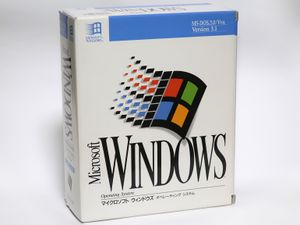
After the success of Windows 3.0, the company sought to create a definite branding for the environment. Preliminary drafts of the new logo featured in some beta builds of Windows 3.1 already featured the same flag shape as the final version, although the panes were blank, the separators between the panes were thicker and the trail used several shades of blue, cyan, magenta and gray. The final logo used by Windows 3.1 and later uses red, green, blue and yellow for the window pane, with the flag's trail continuing the colors of the left-hand side of the window. It is the first one to be used extensively on packaging and within the operating system itself.
Windows XP introduced a new plastic logo, which retains the four colored flag theme, although it removes the window pane and the trail on the left side. The original version, used primarily by Windows XP and Windows Server 2003, is lighted from the left-hand side to give the impression that the logo is indeed waving like a flag. A slightly modified variant was used in early Longhorn builds, where the flag was white rather than four-colored, although later builds reverted to the original coloring.
A newer render was introduced by Windows Vista, which retains the same shape but is lighted from above, making the logo appear flatter than before. This variant often appeared in an blue orb in Windows Vista branding materials such as packaging art and also appeared in a white orb that was formally used as the logo for Windows Live from 2006 to 2009, although this was mostly discontinued with Windows 7. One of the last public appearances of this logo is in the Windows 8 Developer Preview, whose Start button features a flat variation of it using solid colors.
Windows 8 eventually introduced a redesigned logo that reflects the Metro design language, which was designed by Pentagram's Paula Scher.[9][10] The new logo breaks away with the previous brand identity, showing a symbolized blue window at an angle rather than a multi-colored flag. Originally, the logo was cyan, but was later updated to a darker shade of blue with Windows 10. The logo shape was changed in 2021 with Windows 11, which removed the perspective, turning it into four squares similar to the 2012 Microsoft logo.
Neumorphic stylizations of the Windows logo, both the 2012 and 2021 versions, have also appeared since the introduction of Fluent Design System, notably as the Start button icon in Windows 10X and Windows 11. However, the official logo itself still remains flat.
Look and feel
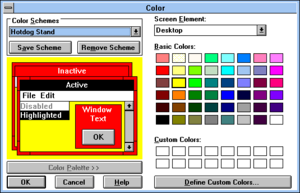
Windows allowed customization of its user interface since its first versions. Windows 1.0 and Windows 2.x allowed the user to change the color scheme in their Control Panel, however, there was no selection of pre-made color schemes and the user could only reset to the default scheme by manually editing WIN.INI. This was improved with Windows 3.0 and its new Colors control panel, which added several color schemes for the user to choose from. Windows NT 3.1 and Windows NT 3.5x also featured the same customization options, although compared to 16-bit Windows where the default preset was provided by the video driver, the defaults were device independent on the new operating system.
Windows 95 introduced a new 3D look, partially inspired by NeXTSTEP, which also continued to support color schemes from earlier versions. Initially, it only made use of solid colors, though this was subsequently refined in Windows 98, which added the ability to use a 2-color gradient for the titlebar. This look and feel was later retroactively renamed to Windows Classic with the introduction of more advanced skinning functionality in later versions.
Visual styles, which support deeper customization of user interface elements, were introduced with Windows XP. The original release shipped with Luna, while later releases also included Royale. However, users could still switch to the Classic theme if they so choose, which was necessary for accessibility functions such as the High Contrast themes that relied on the classic theme's ability to set individual colors. This was further improved with the addition of the Desktop Window Manager in Windows Vista, which allows desktop rendering to make use of hardware acceleration using DirectX and is used for advanced effects such as translucent title bars used by the new Windows Aero theme. For users whose systems did not support the Desktop Window Manager, the operating system also included the software-rendered Windows Basic theme.
The option to disable the DWM was removed in Windows 8, together with the ability to switch to the Classic theme. The Aero Lite theme was introduced in Windows 8 to replace the classic theme, allowing the user to customize its colors to a greater extent than regular visual styles and providing interoperability with the High Contrast accessibility feature. However, the classic theme implementation as well as support for disabled DWM still remains included with Windows for compatibility purposes.
Similarly to other contemporary operating systems, a toggle to switch between light and dark mode was introduced with Windows 10. Originally, this only applied to UWP applications, although it later expanded to also apply to the File Explorer as well as the taskbar. However, the feature mostly avoids the existing visual styles infrastructure and therefore most legacy desktop applications will not use dark mode unless the application manually implements it. Work on a system-wide dark mode was undergoing as late as 2021, but was halted for unknown reasons.[11]
Supported platforms
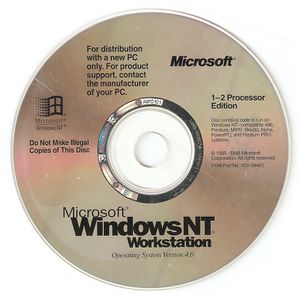
Since its initial release, Windows has supported numerous platforms and systems. The original DOS-based line was constrained to systems based on the 8086 processor and later its successors, most important of which was the IBM PC and its successors, including their clones. However, several IBM-incompatible platforms were also supported, notably the Japanese NEC PC-98 architecture.
It wasn't until the introduction of the portable Windows NT line that Microsoft was able to easily support other processor designs. Originally, NT targeted the Intel i860 processor (codenamed N10 or N-Ten, which is one of the rumored origins for the name of NT). Alongside the operating system itself (codenamed Razzle), Microsoft also designed an i860-based motherboard codenamed Dazzle that uses many standard components from PC/AT system to bridge the difference between the platforms.
The i860 port was soon abandoned due to dissatisfaction with the processor's performance. The system was therefore ported to the i386 and the MIPS R3000 processors, later updated to the R4000. The Dazzle architecture was also adapted for MIPS; the updated design was named Jazz and was eventually used for several MIPS workstations (although this wasn't a requirement for Windows NT support). The firmware used by Jazz was also standardized with the Advanced RISC Computing specification. Both MIPS and x86, as well as future ports, use an ARC boot loader. On x86, which does not use an ARC-compliant firmware, the boot loader is bootstrapped by an ARC emulator which also implements a multi-boot selection menu.
Another port was introduced with an updated release of Windows NT 3.1, which targets the DEC Alpha architecture. The Alpha is different from prior ports in that the CPU is natively 64-bit but unlike the R4000 it cannot run in a 32-bit mode. Nevertheless, Windows NT still uses a 32-bit application binary interface on the platform, relying on sign extension semantics when working with 32-bit values in the 64-bit registers. A PowerPC port, which targets PReP-compliant systems, was introduced with Windows NT 3.5. Intergraph Corporation ported Windows NT to the Clipper architecture and also announced a port to the SPARC architecture, although neither port actually ended up shipping and the company instead ended up marketing x86-based systems running Windows NT.
None of the alternative platforms supported by Windows NT managed to attract a wider userbase, though. The common prediction that RISC-based processor designs would eventually prevail over the CISC-based x86 was broken by the performance improvements introduced by the Pentium and Pentium Pro processors. The non-x86 versions also suffered from lack of available software, because aside from native applications for each architecture the operating system supported only 16-bit x86 applications while the demand for 32-bit x86 applications increasingly grew. Microsoft aimed to tackle this problem via a new subsystem called Wx86 that would support these applications on the alternative platforms, however, support for PowerPC and MIPS was still ultimately discontinued soon after the release of Windows NT 4.0. Despite that, Apple was in negotiations with Microsoft over licensing Windows NT for its Power Macintosh line of systems as late as 1997.
The Alpha port continued to be maintained for several years after the demise of the other ports. In 1996, Digital shipped their FX!32 emulator that also allows 32-bit x86 applications to run on the platform, originally as a separate download for Windows NT 4.0. The emulator was later merged with Wx86 and included with pre-release builds of Windows 2000. However, as Compaq acquired DEC in 1998 and announced that they would be discontinuing Alpha in favor of the upcoming Itanium architecture, the Alpha port of Windows 2000 was canceled as well, despite the fact that Windows 2000 development already reached Release Candidate stage at that point. Alpha builds continued to be built internally by Microsoft even during the development of Windows XP though, as the 64-bit platform proved valuable during the development of 64-bit Windows before Itanium hardware was readily available.
The number of supported processor architectures grew again with the release of Windows XP, which adds support for the original Itanium (codenamed Merced). An updated version of the port, which supports the Itanium 2, was released in 2003 alongside Windows Server 2003. The performance of the architecture proved to be underwhelming, and support for Windows XP 64-Bit Edition was dropped already in 2005 as Itanium workstations were discontinued while Windows Server continued to support IA-64 until Windows Server 2008 R2. Support for AMD64, a 64-bit extension of the x86 architecture, was introduced with Windows Server 2003 Service Pack 1 and Windows XP Professional x64 Edition.
The dependency on ARC-compliant firmware (or the emulation of such) was dropped as a part of a major boot loader rewrite in Windows Vista. This also allowed native support for UEFI firmware on 64-bit x86 platforms to be introduced in Windows Vista Service Pack 1. Support for UEFI on 32-bit x86 was also briefly tested during the development of Vista, but was later dropped. It was later reintroduced with Windows 8, which also removed the last bits depending on BIOS on x86 platforms, finally making Windows UEFI Class-3 compliant.
During the development of Longhorn, Microsoft was experimenting with an ARM port, although it was later scrapped. The idea was later revived for Windows 8 in order to target cheap, low power devices. The version of Windows 8 for ARM devices was called Windows RT, and while it was a full Windows environment, it was artificially limited to only run Windows Store applications and Microsoft-signed desktop applications. This largely contributed to its market failure, and it was discontinued after Windows 8.1. The last major update for Windows RT coincided with the release of Windows 10, with Microsoft backporting an early version of the new Start menu to the Windows 8.1 codebase. The ARM port continued to be maintained in the following years, as shown by Windows 10 build 15035.
Support for ARM64 was later introduced with the Windows 10 Fall Creators Update, which does not suffer from similar limitations as Windows RT. This version has only been made available on devices with Qualcomm chipsets because of an exclusivity deal with Qualcomm (except IoT Enterprise, which is available on devices with NXP chipsets), although it accepts standard product keys and therefore it is possible to install it on non-Qualcomm devices, assuming that drivers are available. Aside from native ARM64 executables, Windows on ARM64 also supports 32-bit ARM applications if supported by the CPU (up to build 25393, 32-bit ARM applications are unsupported since Windows 11 build 25905), as well as 32-bit x86 software under emulation. Support for 64-bit x86 executables was added later with Windows 11 via the xtajit64 emulator (later renamed to Prism).
Support for the 32-bit x86 platform as well as the legacy BIOS boot process was dropped starting by Windows 11, leaving only AMD64 and ARM64 both using UEFI-based firmware.
| Version | x86 | AMD64 (x64) | MIPS | Alpha (AXP) |
PowerPC (PPC) |
Itanium (IA-64) |
ARM | ARM64 | |||
|---|---|---|---|---|---|---|---|---|---|---|---|
| PC/AT | PC-98 | UEFI | PC/AT | UEFI | |||||||
| Windows NT 3.1 | Yes | Yes | No | No | No | Yes | Yes | No | No | No | No |
| Windows NT 3.5 | Yes | Yes | No | No | No | Yes | Yes | Yes | No | No | No |
| Windows NT 3.51 | Yes | Yes | No | No | No | Yes | Yes | Yes | No | No | No |
| Windows NT 4.0 | Yes | Yes | No | No | No | Yes | Yes | Yes | No | No | No |
| Windows 2000 | Yes | Yes | No | No | No | No | No | No | No | No | No |
| Windows XP[a] | Yes | No | No | No | No | No | No | No | Yes | No | No |
| Windows Server 2003[b] | Yes | No | No | Yes | No | No | No | No | Yes | No | No |
| Windows Vista Windows Server 2008 |
Yes | No | No | Yes | Yes | No | No | No | Server | No | No |
| Windows 7 Windows Server 2008 R2 |
Client | No | No | Yes | Yes | No | No | No | Server | No | No |
| Windows 8 Windows Server 2012 |
Client | No | Client | Yes | Yes | No | No | No | No | RT | No |
| Windows 8.1 Windows Server 2012 R2 |
Client | No | Client | Yes | Yes | No | No | No | No | RT | No |
| Windows 10 (up to v1703) Windows Server 2016 |
Client | No | Client | Yes | Yes | No | No | No | No | No | No |
| Windows 10 (since v1709) Windows Server 2019 Windows Server 2022 |
Client | No | Client | Yes | Yes | No | No | No | No | No | Client |
| Windows 11 Windows Server 2025 |
No | No | No | No | Yes | No | No | No | No | No | Yes |
Disclosure of source code
In 2004, incomplete copies of the source code of Windows NT 4.0 and Windows 2000 leaked to the Internet. These leaks were illegal, as the Windows source code is both a trade secret and copyrighted, and as so is protected by law. However, Microsoft has later released parts of the source of the Windows Server 2003 kernel for research purposes in 2008, albeit under a very restrictive license that forbids modifying or distributing both the source and compiled binaries under most circumstances.
In 2017, The Register and other technology journals reported about a leak of the Windows 10 Shared Source Kits, which are available to qualified customers, enterprises, governments, and partners for debugging and reference purposes, to BetaArchive. Following the controversy, BetaArchive removed all source code content from its archives, which also included the aforementioned incomplete copies of the Windows source code and adopted a policy of not accepting any more source code material.
In 2018, the source code of the Windows NT File Manager (winfile) was released on GitHub under the open source MIT license. This was later followed in 2019 by the Windows 10 Calculator application and the console host, the latter of which marks the first core Windows component to be developed out in the open.
In May 2020, a copy of the source code of Windows NT 3.5 build 782.1 leaked to the 4chan /vp/ board. Though it can be compiled for the most part, it lacks source files for some components such as encryption. Another leak later followed in September with the source code of Windows XP Service Pack 1 and Windows Server 2003. The leaked copy is mostly complete, although the activation components are absent within both repositories. It is therefore likely that the leak originated from a Microsoft partner who had access to the source code rather than Microsoft itself. This code base had been apparently circulating in online circles since at least 2015.
Timeline
DOS-based Windows family | |||||
|---|---|---|---|---|---|
| Name | Version | Code name | Release date | Support end date | Notes |
| Windows 1.0 | 1.0 | Interface Manager Window Manager |
1985-11-20 | 2001-12-31 | First release of Windows |
| Windows 2.x | 2.x | Windows 1.5[12] | 1987-12-09 | Introduced overlapping windows | |
| Windows 3.0 | 3.0 | — | 1990-05-22 | Introduced Program Manager | |
| Windows 3.1 | 3.10 | — | 1992-03-08 | An updated version, Windows 3.11, was released in 1993 | |
| Windows for Workgroups 3.1 | Sparta Winball |
1992-10-27 | An updated version of Windows 3.1 with a built-in networking client | ||
| Windows for Workgroups 3.11 | 3.11 | Snowball | 1993-08-11 | — | |
|
Legend:
Never released
Old version
Older version, still supported
Current stable version
Latest preview version
Future release
| |||||
Windows 9x | |||||
| Name | Version | Code name | Release date | Support end date | Notes |
| Windows 95 | 4.00 | Chicago | 1995-08-24 | 2001-12-31 | Introduced the desktop, Start menu and taskbar |
| Windows Nashville | 4.10 | Nashville | — | — | Never released; project goals transferred to Memphis and Internet Explorer 4 |
| Windows 98 | Memphis | 1998-06-25 | 2006-07-11 | Second Edition was released on 5 May 1999 | |
| Windows Millennium Edition | 4.90 | Millennium | 2000-09-14 | — | |
|
Legend:
Never released
Old version
Older version, still supported
Current stable version
Latest preview version
Future release
| |||||
Windows NT family | |||||
| Name | Version | Code name | Release date | Support end date | Notes |
| Windows NT 3.1 | 3.10 | Razzle | 1993-07-27 | 2000-12-31 | First release of Windows NT |
| Windows NT 3.5 | 3.50 | Daytona | 1994-09-21 | 2001-12-31 | — |
| Windows NT 3.51 | 3.51 | — | 1995-05-30 | 2002-09-30 | — |
| Microsoft Cairo | 4.0 | Cairo | — | — | Never released; many of its features were later released as part of other versions |
| Windows NT 4.0 | Shell Update Release | 1996-07-31 | 2004-06-30 | — | |
| Windows NT Server 4.0, Terminal Server Edition | Hydra | 1998-09-13 | 2004-12-31 | — | |
| Windows NT Embedded 4.0 | Impala | 1999-08-30 | 2006-07-11 | — | |
| Windows 2000 | 5.0 | — | 2000-02-17 | 2010-07-13 | — |
| Windows Small Business Server 2000 | — | 2001-04-01 | — | ||
| Windows Odyssey | — | Odyssey | — | — | Never released; was merged with other projects to form Whistler |
| Windows Neptune | 5.50 | Neptune | — | — | |
| Windows XP | 5.1 | Whistler | 2001-10-25 | 2014-04-08 | First NT-based consumer Windows |
| Windows XP 64-Bit Edition | — | 2001-10-25 | 2005-01-05 | Special edition for Itanium-based (IA-64) workstations, mostly analogous to Windows XP Professional | |
| Windows XP Embedded | Mantis[13] | 2001-11-28 | 2016-01-12 | — | |
| Windows XP Media Center Edition | Freestyle Harmony Symphony |
2002-10-28 | 2014-04-08 | Updated versions were released in 2003 and 2004 respectively | |
| Windows XP Tablet PC Edition | Lonestar (2005) | 2002-11-07 | An updated version was released in 2004 | ||
| Windows XP Starter Edition | — | 2004-08-11[14] | Restricted version of Windows XP Home Edition for developing markets | ||
| Windows Embedded for Point of Service | — | 2005-05-24 | 2016-04-12 | — | |
| Windows Fundamentals for Legacy PCs | Eiger | 2006-07-08 | 2014-04-08 | — | |
| Windows Embedded Standard 2009 | Quebec | 2008-10-16 | 2019-01-08 | — | |
| Windows Embedded POSReady 2009 | 2008-12-09 | 2019-04-09 | — | ||
| Windows XP 64-Bit Edition, Version 2003 | 5.2 | — | 2003-03-28 | 2005-01-05 | Updated version of the Windows client for the IA-64 architecture. Based on Windows Server 2003 codebase |
| Windows Server 2003 | Whistler Server | 2003-04-24 | 2015-07-14 | — | |
| Windows Small Business Server 2003 | Bobcat | 2003-10-09 | 2016-04-12 | — | |
| Windows XP Professional x64 Edition | — | 2005-04-25 | 2014-04-08 | First Windows client for the x86-64 architecture. Based on Windows Server 2003 codebase | |
| Windows Home Server | Quattro | 2007-11-04 | 2013-08-01 | — | |
| Windows Vista | 6.0 | Longhorn | 2007-01-30 | 2017-04-11 | Development was reset in 2004 |
| Windows Server 2008 | 2008-02-27 | 2020-01-14[c] | |||
| Windows Small Business Server 2008 | Cougar | 2008-11-12 | 2020-01-14 | — | |
| Windows Essential Business Server 2008 | Centro | — | |||
| Windows Blackcomb | — | Blackcomb | — | — | Canceled successor of Windows XP, and later Longhorn. Dropped in favor of the Windows 7 project |
| Windows 7 | 6.1 | Windows 7 | 2009-10-22 |
2020-01-14[d] |
— |
| Windows Server 2008 R2 | 2020-01-14[c] | — | |||
| Windows Essential Business Server 2008 R2 | Cascades | — | — | Canceled before release due to low interest in the previous version | |
| Windows MultiPoint Server 2010 | Solution Server | 2010-02-24 | 2020-07-14 | — | |
| Windows MultiPoint Server 2011 | WMS 2 | 2011-05-12 | 2021-07-13 | — | |
| Windows Small Business Server 2011 | SBS 7 | 2010-12-13 | 2020-01-14 | — | |
| Windows Embedded 7 | Quebec | 2010-07-29 | 2021-10-12[e] | — | |
| Windows Home Server 2011 | Vail | 2011-04-06 | 2016-04-12 | — | |
| Windows Thin PC | Thin PC | 2011-07-01 | 2021-10-12 | — | |
| Windows 8 | 6.2 | Windows 8 | 2012-10-26 | 2016-01-12 | — |
| Windows Server 2012 | 2012-09-04 | 2023-10-10[f] | — | ||
| Windows MultiPoint Server 2012 | WMS 3 | 2012-10-30 | 2023-10-10 | — | |
| Windows Embedded 8 | — | 2013-04-02 | 2016-01-12 | — | |
| Windows 8.1 | 6.3 | Blue | 2013-10-17 | 2023-01-10 | — |
| Windows Server 2012 R2 | 2013-10-18 | 2023-10-10[f] | — | ||
| Windows Embedded 8.1 | — | 2013-10-17 | 2023-07-11 | — | |
| Windows 10 | 10.0 | Threshold | 2015-07-29 | 2017-05-09[g] | — |
|
Legend:
Never released
Old version
Older version, still supported
Current stable version
Latest preview version
Future release
| |||||
Windows 10 updates | |||||
| Name | Version[h] | Based on | Release date | Support end date | Notes |
| Windows 10 November Update | 1511 | Threshold 2 | 2015-11-10 | 2017-10-10 | — |
| Windows 10 Anniversary Update | 1607 | Redstone 1 | 2016-08-02 | 2019-04-09[i] | — |
| Windows Server 2016 | 2027-01-11 | Long-Term Servicing Channel release | |||
| Windows 10 Creators Update | 1703 | Redstone 2 | 2017-04-05 | 2019-10-08 | — |
| Windows 10 Fall Creators Update | 1709 | Redstone 3 | 2017-10-17 | 2020-10-13 | — |
| Windows Server, version 1709 | Semi-Annual Channel release | ||||
| Windows 10 April 2018 Update | 1803 | Redstone 4 | 2018-04-30 | 2021-05-11 | — |
| Windows Server, version 1803 | Semi-Annual Channel release | ||||
| Windows 10 October 2018 Update | 1809 | Redstone 5 | 2018-11-13 | 2021-05-11[j] | — |
| Windows Server, version 1809 | Semi-Annual Channel release | ||||
| Windows Server 2019 | 2029-01-09 | Long-Term Servicing Channel release | |||
| Windows 10 May 2019 Update | 1903 | Titanium | 2019-05-21 | 2020-12-08 | Also known as 19H1 |
| Windows Server, version 1903 | Semi-Annual Channel release; also known as 19H1 | ||||
| Windows 10 November 2019 Update | 1909 | Vanadium[15][k] | 2019-11-12 | 2022-05-10 | Also known as 19H2 |
| Windows Server, version 1909 | 2021-05-11 | Semi-Annual Channel release; also known as 19H2 | |||
| Windows 10 May 2020 Update | 2004 | Vibranium[15][16] | 2020-05-27 | 2021-12-14 | Also known as 20H1 |
| Windows Server, version 2004 | Semi-Annual Channel release; also known as 20H1 | ||||
| Windows 10 October 2020 Update | 20H2 | 2020-10-20 | 2023-05-09 | — | |
| Windows Server, version 20H2 | 2022-08-09 | Semi-Annual Channel release | |||
| Windows 10 May 2021 Update | 21H1 | 2021-05-18 | 2022-12-13 | — | |
| Windows 10 November 2021 Update | 21H2 | 2021-11-16 | 2024-06-11[l] | — | |
| Windows Server 2022 | Iron | 2021-08-18 | 2031-10-14 | Long-Term Servicing Channel release | |
| Windows 10 2022 Update | 22H2 | Vibranium | 2022-10-18 | 2025-10-14 | — |
|
Legend:
Never released
Old version
Older version, still supported
Current stable version
Latest preview version
Future release
| |||||
Windows 11 and updates | |||||
| Name | Version | Based on | Release date | Support end date | Notes |
| Windows 11 | 21H2 | Cobalt | 2021-10-05 | 2024-10-08 | Codenamed "Sun Valley" |
| Windows 11 2022 Update | 22H2 | Nickel | 2022-09-20 | 2025-10-14 | Codenamed "Sun Valley 2" |
| Windows 11 2023 Update | 23H2 | 2023-10-31 | 2026-11-10 | — | |
| Windows Server, version 23H2 | Zinc | 2023-10-24 | — | First Server Annual Channel release | |
| Windows 11 2024 Update | 24H2 | Germanium | 2024-10-01 | 2027-10-12[m] | — |
| Windows Server 2025 | 2024-11-01 | 2034-10-10 | — | ||
|
Legend:
Never released
Old version
Older version, still supported
Current stable version
Latest preview version
Future release
| |||||
Active development branch | |||||
| Name | Version | Based on | Release date | Support end date | Notes |
| Germanium | — | Germanium | — | — | Current engineering milestone |
| Dilithium | — | Dilithium | — | — | Engineering milestone that took place from January 2024 to August 2024 |
| Selenium | — | Selenium | — | — | Current engineering milestone |
|
Legend:
Never released
Old version
Older version, still supported
Current stable version
Latest preview version
Future release
| |||||
See also
Notes
- ↑ Original release.
- ↑ Includes Windows XP 64-Bit Edition Version 2003 and Windows XP Professional x64 Edition
- ↑ Jump up to: 3.0 3.1 Supported until 10 January 2023, 9 January 2024 for Azure customers and 13 January 2026 for Grandfathered Premium Assurance Support users via the paid Extended Security Updates service for volume licensed Standard, Datacenter and Enterprise copies.
- ↑ Supported until 10 January 2023 via the paid Extended Security Updates service for volume licensed Professional and Enterprise copies.
- ↑ Supported until 10 October 2023 (Standard) or 8 October 2024 (POSReady) via the paid Extended Security Updates service.
- ↑ Jump up to: 6.0 6.1 Supported until 13 October 2026 via the paid Extended Security Updates service.
- ↑ Support for the Enterprise LTSB edition ends on 14 October 2025.
- ↑ Starting with Windows 10 build 10563, the about dialog retrieves the operating system version from the
ReleaseIdin theHKLM\SOFTWARE\Microsoft\Windows NT\CurrentVersionregistry key instead of querying the kernel, which still reports 10.0. Since Windows 10 October 2020 Update, it uses theDisplayVersionstring values from the same key, while theReleaseIdvalue has been frozen at the value "2009". - ↑ Support for the Enterprise LTSB edition ends on 13 October 2026.
- ↑ Support for the Enterprise LTSC 2019 edition ends on 9 January 2029.
- ↑ Vanadium is a cumulative update for version 1903 (Titanium), although it is considered a distinct development semester by Microsoft.
- ↑ Support for the Enterprise LTSC 2021 and IoT Enterprise 2021 editions ends on 12 January 2027 and 13 January 2032, respectively.
- ↑ Support for the Enterprise LTSC 2024 and IoT Enterprise 2024 editions ends on 9 October 2029 and 10 October 2034, respectively.
References
- ↑ http://antitrust.slated.org/www.iowaconsumercase.org/011607/0000/PX00194.pdf
- ↑ http://antitrust.slated.org/www.iowaconsumercase.org/011607/7000/PX07538.pdf
- ↑ http://antitrust.slated.org/www.iowaconsumercase.org/011607/5000/PX05171.pdf
- ↑ https://books.google.com/books?id=XVAEAAAAMBAJ&pg=PT4
- ↑ https://books.google.com/books?id=iVAEAAAAMBAJ&pg=PA103
- ↑ Microsoft. Microsoft to Release Windows XP Home Edition N and Windows XP Professional N in Europe, Microsoft PressPass. 8 June 2005.
- ↑ Evers, Jovers. Windows XP without Media Player gets an 'N', Computerworld. 28 March 2005. Archived from the original on 7 December 2021.
- ↑ Bekker, Scott. European Windows Called 'Windows XP Home Edition N', Redmond. 28 March 2005.
- ↑ https://web.archive.org/web/20120304020844/http://windowsteamblog.com/windows/b/bloggingwindows/archive/2012/02/17/redesigning-the-windows-logo.aspx
- ↑ https://www.pentagram.com/work/windows/story
- ↑ https://www.windowscentral.com/software-apps/windows-11/its-2022-and-windows-11s-dark-mode-is-still-frustratingly-incomplete
- ↑ http://antitrust.slated.org/www.iowaconsumercase.org/011607/3000/PX03414.pdf#page=21
- ↑ https://docs.microsoft.com/en-us/previous-versions/windows/embedded/aa459171(v=msdn.10)
- ↑ https://news.microsoft.com/2004/08/11/microsoft-announces-windows-xp-starter-edition-pilot-program/
- ↑ Jump up to: 15.0 15.1 https://www.zdnet.com/article/what-comes-after-windows-10-19h1-vanadium/
- ↑ https://web.archive.org/web/20191214130318/https://twitter.com/h0x0d/status/1125409514193281024






